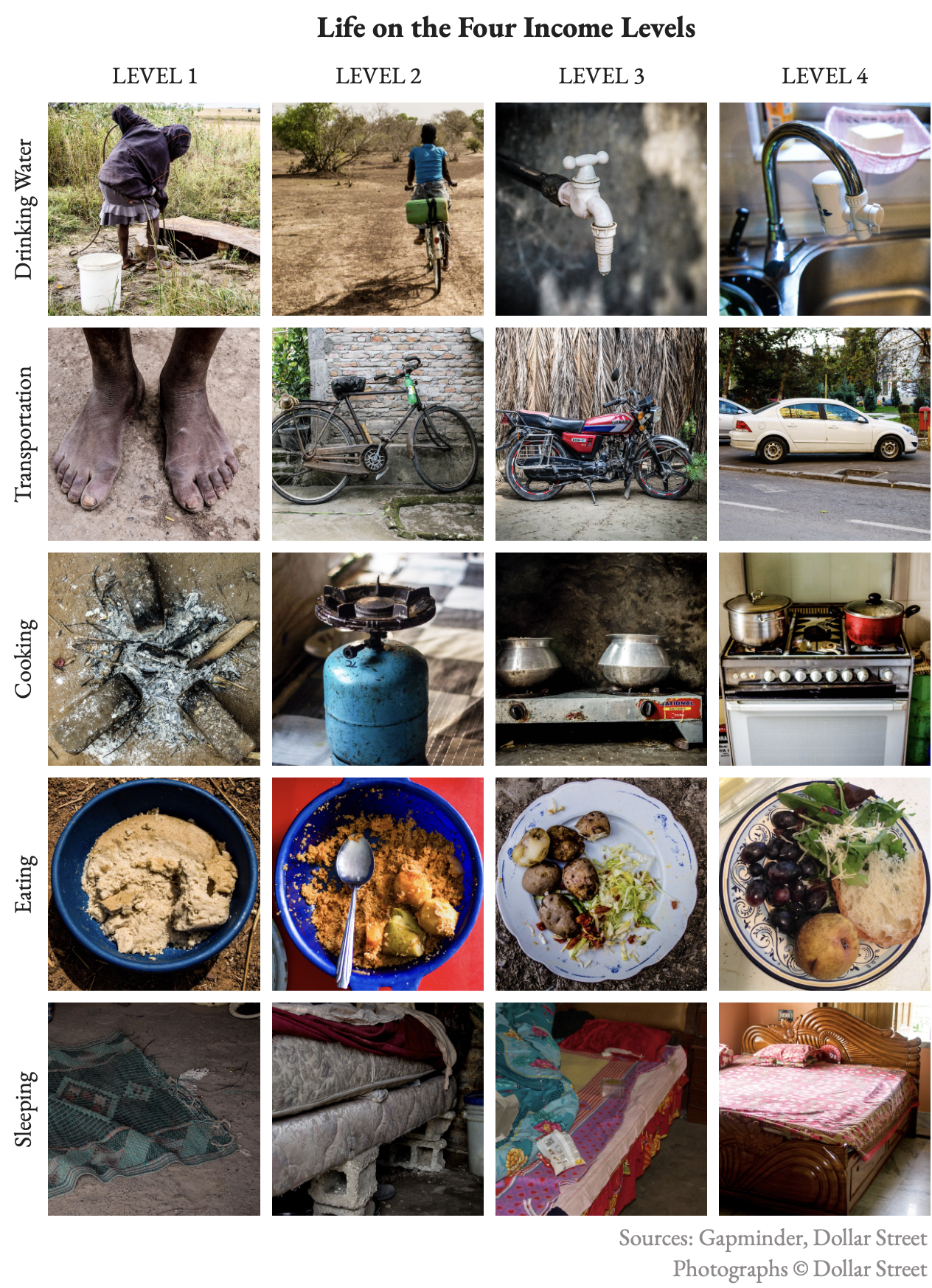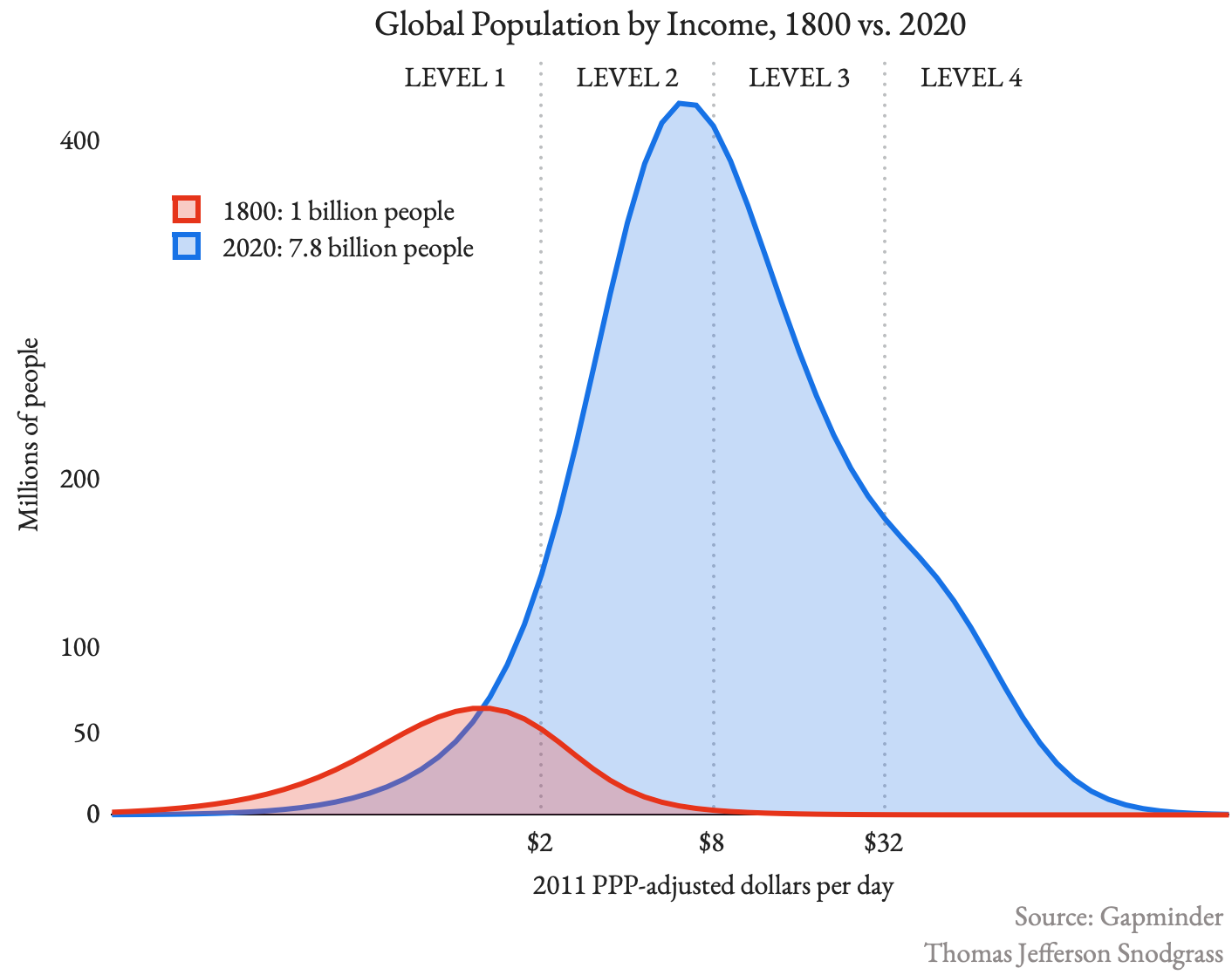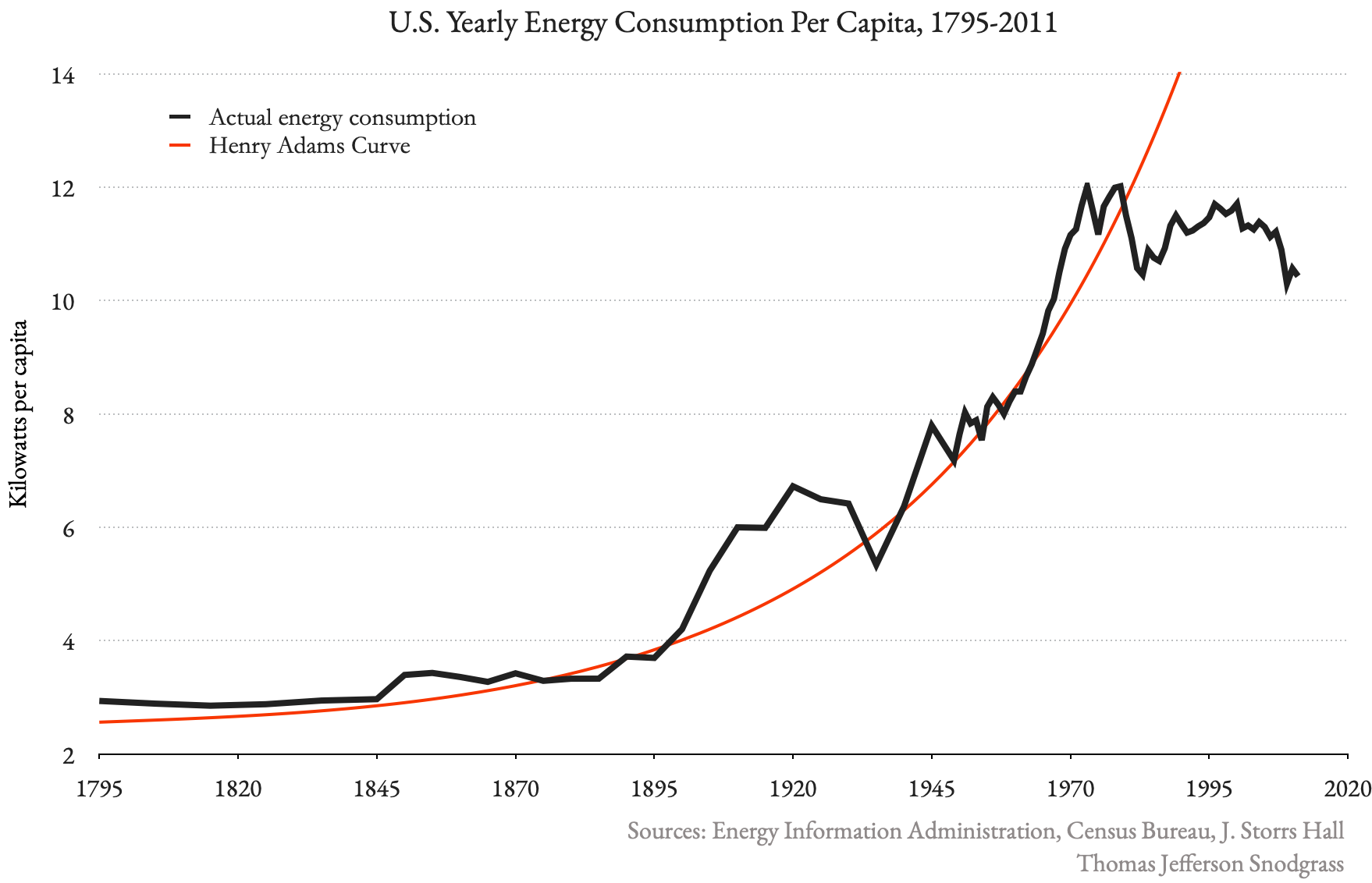Level 5 Society
We tend to forget how completely the Cold War shaped the midcentury view of the world. Countries were categorized by their alignment with the West or the Soviet Union. The American-led liberal democracies constituted the First World, the Eastern Bloc the Second World, and the oft-exploited, unaligned countries the Third World. That way of seeing fell away with the Berlin Wall, and the First-Second-Third World was replaced in the popular conception by the Developed and Developing World.
In his cheery book Factfulness, the late Hans Rosling explains why seeing the world as divided between Developed and Developing nations is plainly wrong. Most of the world is somewhere in the middle, neither rich nor poor. Factfulness proposes a much more accurate framework, breaking societies across four income levels. These levels communicate significant differences in how we live:

- Roughly one billion people live on Level 1. On Level 1, you live in extreme poverty, surviving on less than $2 a day. Your children walk hours each day with a plastic bucket to fetch water. You travel barefoot and cook your food over an open fire. Your family eats the same meager porridge for nearly every meal, and sleeps on a dirt floor.
- Roughly three billion people live on Level 2, between $2 and $8 a day. If you live on Level 2, you can afford food that you didn’t grow yourself, and can buy sandals for your children and a bicycle for travel. Your children attend school, you cook over a gas stove, and you sleep on a mattress.
- Roughly two billion people live on Level 3, between $8 and $32 a day. On Level 3, you have a cold-water tap in your home. You can afford a motorbike for travel. A stable electric line means you can refrigerate food, and your children have better light for doing their homework.
- Roughly one billion people live on Level 4, more than $32 a day. You can take hot showers and have at least a high school education. You can afford to buy a car, dine out, and take an occasional vacation.
Factfulness offers us much to celebrate. In 1800, 85% of of the world lived in extreme poverty. Today, fewer than 9% do, with extreme poverty being halved in just the past twenty years. 80% of people today have been vaccinated against some form of infectious disease. The schooling of girls has almost caught up to that of boys. Bill Gates called it one of the most important books he’s ever read. Rosling with his son and daughter-in-law also built the website Gapminder, filled with tools for seeing the world more clearly.

Beyond the wrongness of the Developed-Developing view, there’s something awfully pernicious about it. The very language seems to imply that the Developed world “has already achieved the achievable,” as Peter Thiel writes in Zero to One. And for all its usefulness, Rosling’s four-level framework doesn’t meaningfully address this problem, which can be restated thus: there is no Level 5 society.
What does Level 5 society look like? Why don’t we see it anywhere? Following Rosling’s logarithmic scale, about 30 million Americans now live on the Level 5 equivalent of at least $128/day.Gapminder calculates these numbers as household income per person per day in 2011 dollars, adjusted for inflation and purchasing power parity. Do they benefit from lifestyle improvements that functionally differ from Level 4? Of course there are differences of degree—bigger houses, better restaurants, travertine bath tile—but perhaps the only principal difference is regular jet travel. Those 30 million Americans still use century-old plumbing and drive themselves around with combustion engines. And we’ve had commercial jet travel for 70 years. As Thiel describes it, “The smartphones that distract us from our surroundings also distract us from the fact that our surroundings are strangely old: only computers and communications have improved dramatically since midcentury.”
If you’re a legislator in a stagnant Western democracy, grasping for a policy that can spring your country up to Level 5, what can you do? What should you do?
The sectors most plagued by rising costs seem like a good place to start. Since the 1960s in the U.S., yearly rent and housing expenditures have grown roughly 1% faster than inflation, K-12 education 2%, college tuition 4%, and healthcare 5.5%. But what if instead there were a master resource, something that affected every sector of the economy, which could be made dramatically cheaper?
I recently read the wonderfully idiosyncratic Where Is My Flying Car? A Memoir of Future Past (which you can buy on Kindle for π dollars). Technologies once thought inevitable have yet to arrive, and J. Storrs Hall wants to know why. Where is the atomically precise manufacturing? Where are the carbon nanotube superstructures and multi-level cities? Where are the robot butlers, ammonia fuel cells, nuclear batteries, weather machines, seasteads, and, of course, the eponymous flying cars?
The rate of scientific and technological progress appears to have slowed since the 1970s. The definitive answer as to why hasn’t yet been written, but Hall offers a plausible explanation: our material comfort and lack of physical frontiers have made self-deception easy. He argues that we’ve created a ruling class of Eloi, the idle, decadent humanoids in H.G. Wells’ The Time Machine. The Enlightenment boons of technological progress and liberal governance have created gyres and updrafts of such power that people can now live most of their lives without ever walking on solid ground.
Hall, following famed historian Henry Adams, observes that there is a long trend in history “going back at least to the Newcomen and Savoury engines of 300 years ago” of usable energy following an exponential curve. Energy use doubled every ten years as a function of population growth, improved energy efficiency, and increased energy consumption. Hall calls it the Henry Adams Curve. “The optimism and constant improvements of the 19th and first half of the 20th centuries can quite readily be seen as being predicated on it.”

But then something strange happened in the 1970s: we fell off of the Henry Adams Curve. Energy use has been stagnant ever since. Hall acidly observes that if you didn’t know any better you’d think the job of the Department of Energy (established 1977) was to prevent energy use. Static or declining energy use may be a warning sign that society is no longer driven by progress, but rather by entropy and inertia.
All else being equal, of course reduced energy consumption is desirable. But all else isn’t equal. Nowadays we conflate energy use in general with the costs and risks of particular forms of energy, like air pollution from hydrocarbons. Energy use feels dirty (and with hydrocarbons it is), but our ability to harness energy is one of the most vital ingredients for human progress. Think about the staples of your daily life. Energy-intensive products include steel, glass, cement, clean water, and smartphones. Vaccines and fresh food rely on cold chains. And of course there’s the internet. What if the economic, health, and environmental costs of all that energy use could be made trivial?
The tragedy in all this is that we have the technology, right now, to break out of our stasis, and yet have allowed it to languish: nuclear power.
The vintage nuclear power plants in operation today—designed in the ‘60s and built in the ‘70s—are already the safest form of energy we have, emitting practically zero greenhouse gasses and causing fewer deaths per unit of energy produced than anything else available. But nuclear power ran up against social and political resistance, new regulatory burdens were imposed, and new power plant construction slowed to a crawl. Had we simply continued the nuclear power trends of the ’50s and ’60s instead of pulling the regulatory emergency brake, we’d have avoided 174 gigatons of carbon emissions and 9.5 million deaths from burning gas and coal.
What’s more, modern designs address all of the lingering fears over nuclear power. Molten salt reactors, using thorium instead of uranium, are prohibitively difficult to weaponize, emit less radiation per unit of energy produced than coal-fired power plants, and cannot melt down. Yes, it’s expensive to build new reactors, but that’s because we’ve made it so: regulatory compliance dominates new construction costs.
Achieving a Level 5 society may be straightforward (not easy, but straightforward): with energy that’s too cheap to meter. Today you pay for internet not by the megabyte, but simply for a certain upload/download speed. Imagine paying for your electricity similarly: not by the kilowatt-hour, but at a flat monthly rate for a given wattage. In the near future, conserving household energy can feel as quaint as restricting your internet traffic.
There’s a real argument to be made that, if we’re serious about Level 5 society, we should devote as much public spending as possible toward building a modern fission energy infrastructure and as much effort and ingenuity as possible toward reforming its regulatory framework, not because other policy goals are unworthy, but because they will all—every single one of them—be made dramatically easier to achieve with clean, affordable, abundant energy. “Put all your eggs in one basket,” Andrew Carnegie once advised, “and then watch the basket.”
Energy is a master resource for civilization, and widespread fission energy means cheaper everything. It means better healthcare and faster drug discovery. It means eradicating poverty. It means the end of air pollution. It means Mars colonies. It means an energy infrastructure dramatically less reliant on foreign oil, federal subsidies, and toxic mining for rare earth metals.
Jorge Luis Borges once wrote that all history may be the history of a handful of metaphors. I sometimes wonder how much of history is nothing more than the history of harnessed energy. I won’t go so far as to say that mastery of energy is sufficient for improving the human condition, but the record is clear from fire on down that progress is awfully barren without it.